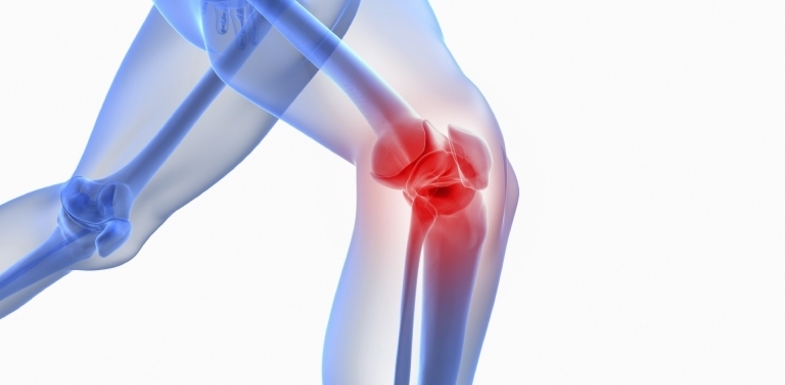Chronic knee pain can have a dramatic effect on our daily lives. As a weight-bearing joint, your knee takes a lot of pressure across a lifetime, sometimes with debilitating results. If you suffer from chronic knee pain, a genicular nerve block might be a good treatment option for you. Here’s what you should know.
What is a genicular nerve block?
Nerves wind through all of the joints in our bodies, and the knee is no different.
Your knee is a large, complex joint made up of four bones: the femur, the tibia, the fibula, and the patella. These bones are stabilized by the muscles of the quadriceps, hamstrings, and calves.
Ligaments and cartilage provide further connection and support. They include:
- The anterior cruciate ligament (ACL): Connects the femur to the tibia and stabilizes the knee joint
- The posterior cruciate ligament (PCL): Prevents the femur from moving forward of the tibia
Two collateral ligaments, medial and lateral, keep the knee aligned with the femur and the tibia from top to bottom.
Meniscus tissue (lateral and medial) provides easy movement between the femur and the tibia. Additional cartilage cushions the patella from behind. And for comfortable movement, fluid-filled sacs called bursae cushion the knee joint and prevent bones from rubbing against one another.
Pain relief
Woven throughout this entire joint is a complex network of nerves and arteries, collectively referred to as the genicular nerves. A genicular nerve block uses an anesthetic injected into the sides of the knee to relieve knee pain from a variety of causes. This knee pain might be sporadic, only occurring at night, or it might be constant and interfere with every step you take.
Additionally, a genicular nerve block for knee surgery can provide lasting pain relief as you recover and rehabilitate this joint. This type of pain control delivers targeted relief directly where it’s needed—without the potential side effects of oral pain medications.
Diagnosis
Genicular nerve blocks are used for knee pain, but they have other uses, too. When the cause of your pain is unclear, this type of joint injection can also be used as a diagnostic tool. For example, if a genicular nerve block relieves at least 50% of your knee pain, it indicates that you may be a candidate for a more permanent pain solution like radiofrequency ablation.
Radiofrequency ablation (RFA) for knee pain is a procedure that uses a weak electrical current to damage pain-signaling nerves in the knee. Many patients have experienced long-term pain relief and increased mobility with RFA.
How does a genicular nerve block work?
A genicular nerve block for knee pain is placed in several different locations in your knee. The anesthetic blocks the pain-signaling nerves in the knee. This does not treat any underlying conditions that are causing pain, but it does allow for other treatments or rehabilitative exercise to occur, pain-free.
Sometimes a corticosteroid will be injected for inflammation, as well. But unlike other joint injections, a genicular nerve block is most frequently simply an anesthetic medication with no steroid.
Benefits of genicular nerve blocks
Genicular knee blocks come with a host of benefits, some of which we discuss in more detail below. Overall, there are several benefits that are common for all conditions eligible for this procedure.
To start, a genicular knee block is minimally invasive with a low risk of side effects or complications. It can help relieve pain safely so that you can begin other treatments (e.g. physical therapy or other targeted exercise).
Genicular nerve blocks can also help you avoid more invasive knee surgeries when other conservative pain control methods are not working. It’s a good option for people who are not eligible for surgery but need pain control without oral medications.
Finally, because a genicular nerve block does not require a steroid to be effective, it’s a good option for people who are allergic to steroids or wish to avoid potential steroid side effects.
There are other benefits unique to specific causes of knee pain, too.

Osteoarthritis
Osteoarthritis is one of the most common causes of chronic knee pain. It can also be one of the most stubborn to treat. For intractable osteoarthritis, researchers have found that a genicular nerve block (with or without a corticosteroid) provided pain relief that lasted for at least two weeks. For people concerned about the side effects of steroids, this is good news—anesthetic alone was just as effective.
Research has also found that those who suffer from osteoarthritis knee pain and experience pain relief from a genicular nerve block are good candidates for long-term radiofrequency ablation.
Chronic knee pain
Osteoarthritis is the most common cause of chronic knee pain, but it’s not the only one. Gout, tendinitis, and injury can cause pain and swelling that is either episodic or constant.
These conditions are approached with a variety of treatments that includes addressing the underlying condition while relieving pain with a knee nerve block.
Failed total or partial knee replacement
While most people who undergo total or partial knee replacement have good results, for some, pain and swelling marks a failure of the implant. It might shift and become loose, causing tremendous pain, swelling, and instability in the knee.
Whether a knee revision surgery is performed or not, a genicular nerve block can help control pain before and after this procedure.
Pain management during and after knee surgery
Genicular nerve block for knee surgery can speed recovery and provide more comfort than oral pain medications. Patients who received a genicular nerve block for knee pain after surgery also took less than half the dosages of opioids during their recovery and up to a week afterward. They also reported lower pain scores than patients who did not receive a genicular nerve block.
As a minimally invasive procedure with few risks, side effects, or potential drug interactions, these are promising study results for those undergoing knee replacement.
What can I expect with a genicular nerve block procedure?
Unlike some nerve blocks that target a single nerve, a genicular nerve block is placed in at least three separate locations in the knee for best results. These nerves are located at the top of the knee, on the inside and outside of the knee, and below the knee on the inside of the leg.
This procedure is performed on an outpatient basis with local anesthetic. It’s best to bring a friend or family member to drive you home, but they won’t have to wait long. The entire procedure takes less than 30 minutes.
You’ll position yourself on the exam table, and the injection areas will be cleaned and sterilized. A numbing medication applied to the skin provides comfort during the injections. If you are anxious about the procedure or concerned about pain, talk to your doctor about mild sedative options.
Once your skin is numb, your doctor uses X-ray guidance to properly place the injections, but here’s another difference from other joint injections. This time, medications are injected outside of the joint. This cuts the pain signaling off where the nerves begin (instead of waiting until they hit the joint itself).
You may start to feel pain relief within minutes. Your doctor may ask you to walk around for a bit to see if the medication takes immediate effect (even if it’s not fully working). After 15 minutes or so, you’ll be released to go home and rest for the remainder of the day.
Recovery
It’s important to talk to your doctor for specific recovery instructions. This is especially true if you are treating underlying conditions or other health issues at the same time.
In general, there are some common guidelines for your recovery. As noted above, it’s best to have someone drive you home the day of your knee nerve block. Some people experience numbness in their leg, so driving is off the table for the first 24 hours.
During that time, it’s okay to move around, but best to avoid any strenuous activity. This includes exercise or standing for long periods of time. Take the day off and rest.
You may notice mild swelling, bruising, or soreness at the injection sites. Over-the-counter, non-steroidal anti-inflammatory medications like ibuprofen and naproxen sodium can help. Take only as directed by your doctor. You can also apply ice to ease swelling in a 20 minutes on, 20 minutes off pattern as needed.
Keep track of your pain levels in the days following your procedure. It can be helpful to keep a pain diary to note when and if you feel any changes to your pain. It is normal to feel a dramatic drop in pain directly after your nerve block for knee pain, followed by a slight increase before pain levels stabilize.
Side effects
Although the risks of genicular nerve block are few, it’s important to note them. They can include the following:
- Drug allergy
- Heavy bleeding
- Increase in pain
- Nerve damage
- Tissue damage
These risks are very rare. Most of these risks can be prevented by using X-ray guidance to place the injections and practicing proper sterilizing of the injection site. Talk to your doctor if you have had an allergic reaction to anesthesia in the past.
Whenever a medical procedure punctures the skin, though, the risk for infection exists. Call your doctor if you experience any of the following symptoms, as they may be a sign of infection:
- Heat, redness, or excessive swelling in the knee
- Oozing or bleeding at the injection site
- Fever
- General feeling of being unwell
Length of pain relief
Pain relief is as individual as each patient who receives a genicular nerve block. In general, most patients experience some level of pain relief immediately after the block is administered. For some patients, pain is completely relieved for a few hours. Others experience total or partial relief for days, weeks, and even months.
It is difficult to predict how long a genicular nerve block will relieve pain. Talk to your doctor about what you can expect.
Integrated pain management treatments
A genicular nerve block works best when it’s part of a comprehensive treatment plan. Chances are good that your journey to pain relief won’t start with a nerve block. It’s important to explore integrated pain management treatments that include not only interventional procedures, but also lifestyle changes that include diet, exercise, and complementary therapies (like physical or biofeedback therapy).
As noted, with a successful genicular nerve block, you may also be a candidate for radiofrequency ablation. Genicular radiofrequency ablation offers the possibility of long-term pain relief that has few side effects and can be repeated as needed with no ill effects.
Study after study has found significant pain relief for as long as six months after a single radiofrequency ablation procedure. Limited risks are associated with this procedure as well, making it a good option for people who cannot have knee surgery.
Our pain specialists at Arizona Pain develop individualized pain management plans for every patients. A genicular nerve block for knee pain can be key to helping you get your life back. Schedule an appointment to talk with one of our pain doctors today!
